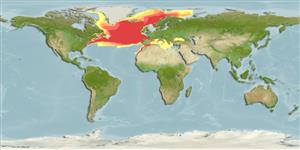>
Gadiformes (Cods) >
Gadidae (Cods and haddocks)
Etymology: Micromesistius: Greek, mikros = small + greek, mesos = middle + Greek, istion = sail (Ref. 45335).
More on author: Risso.
Environment: milieu / climate zone / depth range / distribution range
Ecología
marino batipelágico; oceanodromo (Ref. 51243); rango de profundidad 150 - 3000 m (Ref. 3663), usually 300 - 400 m. Temperate; 79°N - 26°N, 82°W - 51°E (Ref. 1371)
Northeast Atlantic: Barents Sea south through the eastern Norwegian Sea, around Iceland, then in the western Mediterranean, and south along the African coast to Cape Bojador. Northwest Atlantic: southern Greenland and off southeast Canada and the northeastern coast of the USA.
Length at first maturity / Tamaño / Peso / Age
Maturity: Lm 15.0 range ? - ? cm
Max length : 55.5 cm TL macho / no sexado; (Ref. 106276); common length : 22.0 cm TL macho / no sexado; (Ref. 1371); peso máximo publicado: 830.00 g (Ref. 40637); edad máxima reportada: 20 años (Ref. 1371)
Espinas dorsales (total): 0; Radios blandos dorsales (total): 24-28; Radios blandos anales: 33 - 39. Dorsal fins widely spaced, interspace between second and third fins longer than base length of first dorsal fin. Lateral line continuous over whole body. Color is blue-gray dorsally, grading to white ventrally. Sometimes with a small black blotch at the base of the pectoral fin.
Found over the continental slope and shelf to more than 1000 m, but more common at 300-400 m. Feeds mostly on small crustaceans but large individuals also prey on small fish and cephalopods. Makes daily vertical migrations: surface waters at night and near the bottom during the day. Sold fresh and frozen, and also processed as oil and fishmeal (Ref. 1371).
Oviparous and gonochorous (Ref. 205).
Cohen, D.M., T. Inada, T. Iwamoto and N. Scialabba, 1990. FAO species catalogue. Vol. 10. Gadiform fishes of the world (Order Gadiformes). An annotated and illustrated catalogue of cods, hakes, grenadiers and other gadiform fishes known to date. FAO Fish. Synop. 125(10). Rome: FAO. 442 p. (Ref. 1371)
IUCN Red List Status (Ref. 130435)
Threat to humans
Harmless
Human uses
Pesquerías: muy comercial
Herramientas
Special reports
Download XML
Fuentes de Internet
Estimates based on models
Preferred temperature (Ref.
123201): 3.1 - 13.9, mean 7 °C (based on 157 cells).
Phylogenetic diversity index (Ref.
82804): PD
50 = 0.7500 [Uniqueness, from 0.5 = low to 2.0 = high].
Bayesian length-weight: a=0.00417 (0.00343 - 0.00507), b=3.12 (3.06 - 3.18), in cm total length, based on LWR estimates for this species (Ref.
93245).
Nivel trófico (Ref.
69278): 4.1 ±0.3 se; based on diet studies.
Generation time: 4.8 (3.1 - 5.0) years. Estimated as median ln(3)/K based on 15
growth studies.
Resiliencia (Ref.
120179): Medio, población duplicada en un tiempo mínimo de 1.4-4.4 años (K=0.18-0.22; tm=1-5; tmax=20; Fec=6000).
Prior r = 0.47, 95% CL = 0.31 - 0.71, Based on 11 stock assessments.
Fishing Vulnerability (Ref.
59153): Low to moderate vulnerability (32 of 100).
Climate Vulnerability (Ref.
125649): Low vulnerability (18 of 100).
Nutrients (Ref.
124155): Calcium = 59.8 [18.9, 176.3] mg/100g; Iron = 0.423 [0.151, 1.166] mg/100g; Protein = 17.6 [15.2, 20.1] %; Omega3 = 0.249 [0.113, 0.554] g/100g; Selenium = 8.99 [2.88, 24.62] μg/100g; VitaminA = 33.2 [3.4, 311.2] μg/100g; Zinc = 0.712 [0.380, 1.580] mg/100g (wet weight); based on
nutrient studies.
